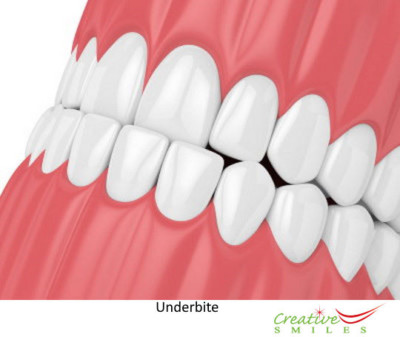An underbite is a dental word for a forward-protruding lower jaw. The lower jaw extends beyond the upper teeth as a result of this. The degree of an underbite can range from a minor underbite in which the lower jaw overlaps the upper jaw to a severe underbite in which the teeth do not contact due to the large gap. Learn Porcelain treatment.
What Causes an Underbite? | Types of Underbites | What issues does an underbite cause? | How to Treat an Underbite | Overbite Vs Underbite
What Causes an Underbite?
 Your teeth typically grow in such a way that the higher teeth fit over the lower teeth. The molars should be able to fit into each other. Several circumstances, however, contribute to a person’s development of such a disorder. Here are a few examples:
Your teeth typically grow in such a way that the higher teeth fit over the lower teeth. The molars should be able to fit into each other. Several circumstances, however, contribute to a person’s development of such a disorder. Here are a few examples:
Genetics
If someone in your family has the disease, you’re more likely to have it. The jaw, tooth form, and size are also determined by genetics.
As a result, some people are born with teeth that are crowded together, impacted, do not develop all of their teeth (hypodontia), are irregularly shaped, overjet, or do not fit together.
Childhood Habits
An underbite might develop as a result of certain childhood practices. The following are some of the habits:
- Pushing of the teeth using the tongue
- Use of a pacifier for children above three years old
- Thumb sucking (can also cause tongue thrust.)
- Nail biting
- Long-term bottle-feeding
- Habits of poor oral hygiene (which also causes dental plaque and tooth decay)
Injury
Jawbones can be permanently damaged by severe trauma. A fractured jawbone may typically be repaired, however even after surgical realignment, the jaws usually don’t fit together properly.
Tumors
Tumors in the jawbones or mouth can cause the jaws to protrude, resulting in an underbite.
Types of Underbites
There are two types of underbites.
Skeletal underbites this type of underbite forms because of the malformation of the jawbone. This type of malocclusion is usually genetic.
Dental underbites is a type of teeth misalignment and it occurs when crossbite appears in the front of the mouth rather than the sides. The teeth are slightly forward, but the lower jaw does not stick out.
What Issues Does an Underbite Cause?
An underbite isn’t merely an aesthetic problem. According to the American Dental Association (ADA), the more serious this illness is, the more likely it is to produce oral health issues like:
- Challenges when speaking
- Difficulty in biting and chewing the food
- Prognathism
- Mouth, and face pain due to malocclusion.
- Sleep apnea
- Excessive wear of the tooth enamel
- Chronic mouthbreathing and bad breath
Furthermore, if you have a visible underbite, it will impact your self-confidence.
How to Treat an Underbite
At least most of the tooth eruption of the permanent teeth has taken place, it is usual for the teeth to have a small misalignment. In other circumstances, however, if the underbite is severe enough, those who have their underbite fixed will reap more significant advantages. Allow Creative Smiles to assist you in correcting your underbite issues. Clinical medicine cannot cure underbite alone.
Below are some of those benefits:
- It is easier to brush and floss your teeth.
- It avoids the risks of developing diseases in the gums.
- Your jaws, teeth, and facial muscles will experience less strain.
- Reduces the chance of developing a temporomandibular joint disorder
- Reduce your chances of getting dental abscess.
- It reduces the risk of breaking a tooth or tooth loss
The only way to get rid of this problem is to have it professionally aligned. An orthodontist is needed to correct this problem. Amit Shah
can correct your underbite using one of the following methods:
Tooth Extraction – Crowding can be relieved by removing a tooth, allowing biting to occur more naturally.
Braces -The most frequent orthodontics treatment for an underbite is a brace. Dental braces are obvious when you talk or smile since they are not inconspicuous. This is fixed using clear braces.
Appliances – To treat such a problem, certain equipment can be employed. Because they are more obvious than braces, they are custom-made for your mouth and might be unpleasant. When this therapy is required, orthodontists advise it.
The reverse full facemask is an orthodontic device. This device resembles orthodontic headgear in that it wraps around your head. This method of treating underbite includes connecting metal bands to your upper back teeth so that the device may gently move your upper jaw into place.
The upper jaw expander is a different sort of dental device. With a screw in the centre, the upper jaw expander fits over the upper jaw’s rear teeth. The purpose is to extend the upper jaw, broaden the dental arch, and relocate the teeth within the bone. However, the pathology of the maxilla and mandible must be taken into consideration.
Surgery – If the orthodontist considers that all other treatments have failed, this should be considered as a last resort. Surgery is seldom required to correct an underbite, therefore it only happens on rare instances.
Orthognathic surgery is a kind of jaw surgery. This is a one-of-a-kind operation that includes splitting your jawbones and making customized adjustments to your jaw position.
If you have a cleft lip or palate, you may need surgery before fixing your underbite.
Overbite Vs Underbite
When your mouth is closed, an overbite occurs when your upper teeth overlap your lower teeth excessively. When you have a smaller jaw or your lower jaw is shorter than your upper jaw, you are more likely to develop this problem. More about Bite Alignment upper and lower jaw line.
When your mouth is closed, your lower jaw lies in front of your upper jaw, causing an underbite. When you have this issue, you may often appear to have a protruding chin, however in less severe cases, this may be more muted. Schedule an appointment.
Published on February 12, 2022, Updated on March 26, 2022
